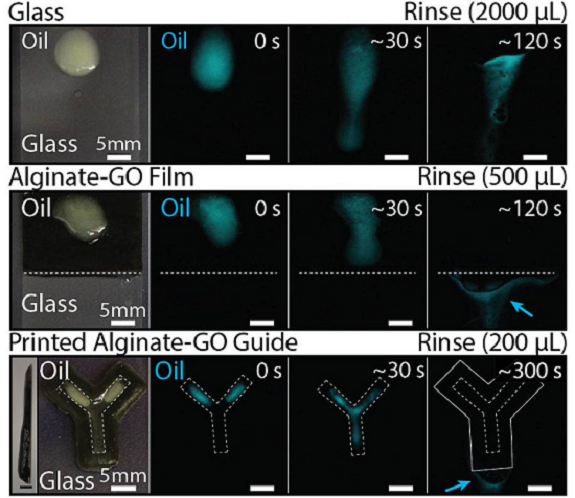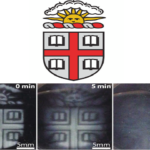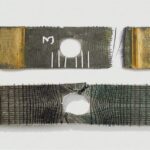
 Usually when I think about seaweed, I’m trying to decide which particular sushi roll to order at dinner. But a team of researchers from Brown University in Rhode Island, which is well-versed in unique 3D printing materials, used 3D printing to create a smart composite material out of graphene oxide and alginate derived from seaweed that can change in response to its environment. The team recently published a paper on their new hybrid material, titled “Alginate-graphene oxide hydrogels with enhanced ionic tunability and chemomechanical stability for light-directed 3D printing,” in the Carbon journal.
Usually when I think about seaweed, I’m trying to decide which particular sushi roll to order at dinner. But a team of researchers from Brown University in Rhode Island, which is well-versed in unique 3D printing materials, used 3D printing to create a smart composite material out of graphene oxide and alginate derived from seaweed that can change in response to its environment. The team recently published a paper on their new hybrid material, titled “Alginate-graphene oxide hydrogels with enhanced ionic tunability and chemomechanical stability for light-directed 3D printing,” in the Carbon journal.
While seaweed-derived alginate is already used in biomedical applications, hydrogels made from this material are not very strong.
“One limiting factor in the use of alginate hydrogels is that they’re very fragile — they tend to fall apart under mechanical load or in low salt solutions. What we showed is by including graphene oxide nanosheets, we can make these structures much more robust,” explained research leader Thomas Valentin, a PhD student in Brown’s School of Engineering, in a university news release.
Using carbon-based graphene to reinforce the material makes it more robust and durable, so it can be used to help design additional smart materials that respond to external stimuli – making it perfect for use in other applications, such as marine and environmental. The use of stereolithography makes it possible to create stiff, intricate alginate-GO composite structures that are far more fracture resistant than alginate is on its own.
This ability to change the material’s stiffness also makes it a good fit for applications in dynamic cell cultures.
Valentin explained, “You could imagine a scenario where you can image living cells in a stiff environment and then immediately change to a softer environment to see how the same cells might respond.”
Ionic bonds linking the sodium alginate polymers cause the material to dynamically respond to its environment: these bonds are strong enough to keep the material together, but certain chemical treatments can break them apart. The researchers proved this ionic crosslinking in previous experiments, and it can be used to create alginate materials that will rapidly degrade on demand once a chemical treatment “sweeps away ions from the material’s internal structure.”
Once the material has been treated with the chemical that removes its ions, it will swell up and become softer; only after bathing in ionic salts will the ions be restored to make the material stiff again. The researchers found that just by changing up the material’s external ionic environment, they could tune its stiffness over a factor of 500.

According to Ian Y. Wong, an assistant professor of engineering at Brown, graphene oxide can actually change the mechanical properties of alginate structures, which means that the team’s new composite material can be made to be much more resistant to failure caused by cracking. This made it possible to 3D print stiff structures with overhanging parts, which alginate by itself could not do.
“The addition of graphene oxide stabilizes the alginate hydrogel with hydrogen bonding. We think the fracture resistance is due to cracks having to detour around the interspersed graphene sheets, rather than being able to break right though homogeneous alginate,” Wong explained.
In addition, the team’s new material is oil-resistant, which means that it could be used as a coating in marine applications to halt oil build-up.
Wong explained, “These composite materials could be used as a sensor in the ocean that can keep taking readings during an oil spill, or as an antifouling coating that helps to keep ship hulls clean.”
The researchers will continue their work with their smart graphene oxide-seaweed hybrid material, including searching for ways to optimize its properties, efficiently mass produce it, and find new uses.
Co-authors of the paper are Valentin, Alexander K. Landauer, Luke C. Morales, Eric M. DuBois, Shashank Shukla, Muchun Liu, and Lauren H. Stephens of Brown University, as well as Christian Franck from the University of Wisconsin and Po-Yen Chen with the National University of Singapore.
Discuss this research and other 3D printing topics at 3DPrintBoard.com or share your thoughts in the comments below.
[Source: Design News]
If you're looking for affordable 3D visualization services in the USA, our platform provides an ideal solution for all your architectural and real estate needs. Through our service, you can access high-quality 3D renderings at competitive prices without compromising on quality. Whether you need interior visualizations, exterior renderings, or architectural animations, our team ensures that you get professional results that fit within your budget. With our support, you can make your projects visually stunning while saving on costs, all with a quick and straightforward process.
Through our site, you can easily order affordable 3D visualizations for your projects, whether for a residential property, commercial development, or architectural design. We understand the importance of staying within budget, and that's why we offer tailored solutions to ensure you get the best value for your investment. Our experts work efficiently to provide you with realistic, photorealistic 3D images that will elevate your presentations and attract clients, making your property stand out in the market.






